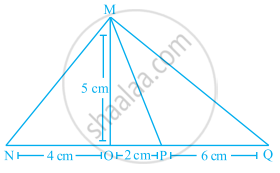Advertisements
Advertisements
प्रश्न
prove that the points A (7, 10), B(-2, 5) and C(3, -4) are the vertices of an isosceles right triangle.
उत्तर
The given points are A (7, 10), B(-2, 5) and C(3, -4).
`AB= sqrt((-2-7)^2 +(5-10)^2) = sqrt((-9)^2 +(-5)^2) = sqrt((81+25)) = sqrt(106)`
`BC = sqrt((3-(-2))^2 +(-4-5)^2) = sqrt((5)^2 +(-9)^2 )= sqrt((25+81) )= sqrt(106)`
`AC = sqrt((3-7)^2 +(-4-10)^2) = sqrt(( -4)^2 +(-14)^2) = sqrt(16+196) = sqrt(212)`
Since, AB and BC are equal, they form the vertices of an isosceles triangle
Also,`(AB)^2 + (BC)^2 = ( sqrt(106))^2 +( sqrt(106)^2) = 212`
and `(AC)^2 = (sqrt(212))^2 = 212.
`Thus , (AB)^2 + (BC)^2 = (AC)^2`
This show that ΔABC is right- angled at B. Therefore, the pointsA (7, 10), B(-2, 5) and C(3, -4). are the vertices of an isosceles rightangled triangle.
संबंधित प्रश्न
Find the area of the quadrilateral ABCD whose vertices are respectively A(1, 1), B(7, –3), C(12, 2) and D(7, 21).
For what value of k(k>0) is the area of the triangle with vertices (-2, 5), (k, -4) and (2k+1, 10) equal to 53 square units?
Find the value of p for which the points (−5, 1), (1, p) and (4, −2) are collinear.
The table given below contains some measures of the right angled triangle. Find the unknown values.
| Base | Height | Area |
| 5 feet | ? | 20 sq.feet |
If the points (2, -3), (k, -1), and (0, 4) are collinear, then find the value of 4k.
The points (0, 5), (0, –9) and (3, 6) are collinear.
Find the values of k if the points A(k + 1, 2k), B(3k, 2k + 3) and C(5k – 1, 5k) are collinear.
The area of a trapezium is 475 cm2 and the height is 19 cm. Find the lengths of its two parallel sides if one side is 4 cm greater than the other.
Ratio of areas of ∆MNO, ∆MOP and ∆MPQ in the given figure is ______.

Using determinants, find the area of ΔPQR with vertices P(3, 1), Q(9, 3) and R(5, 7). Also, find the equation of line PQ using determinants.
